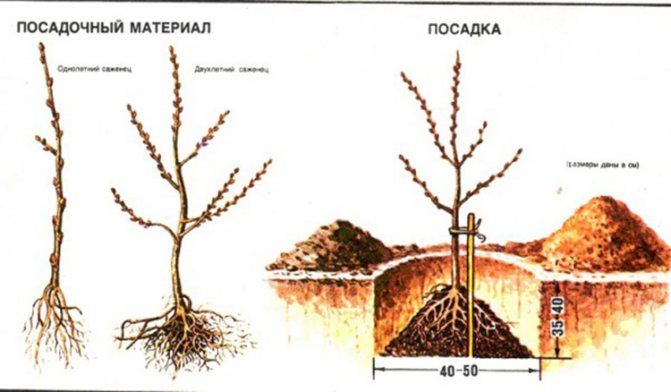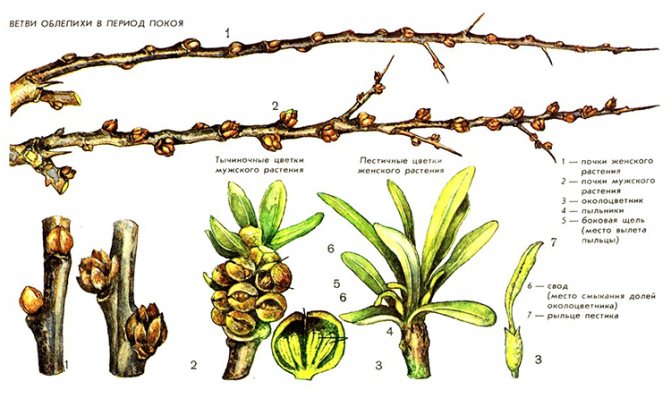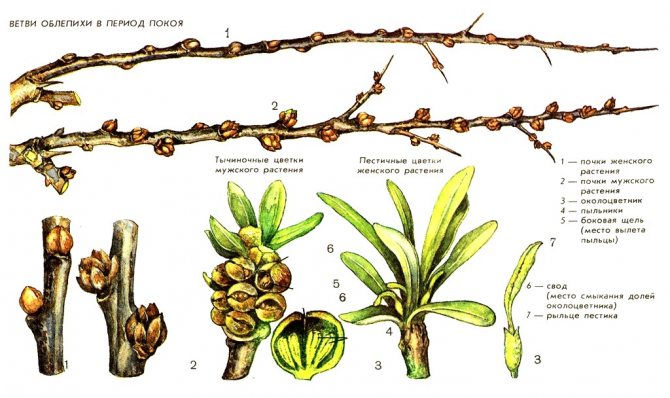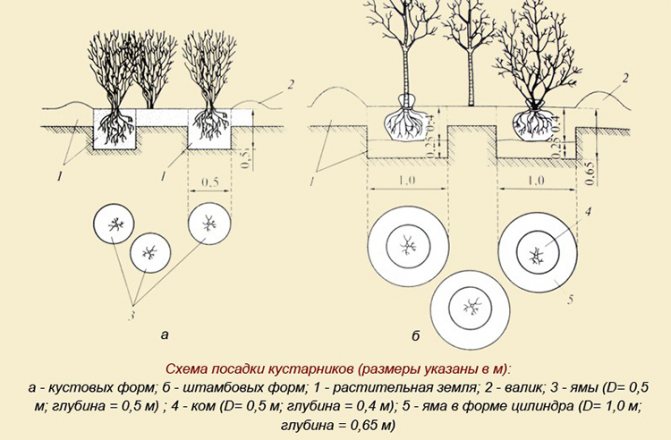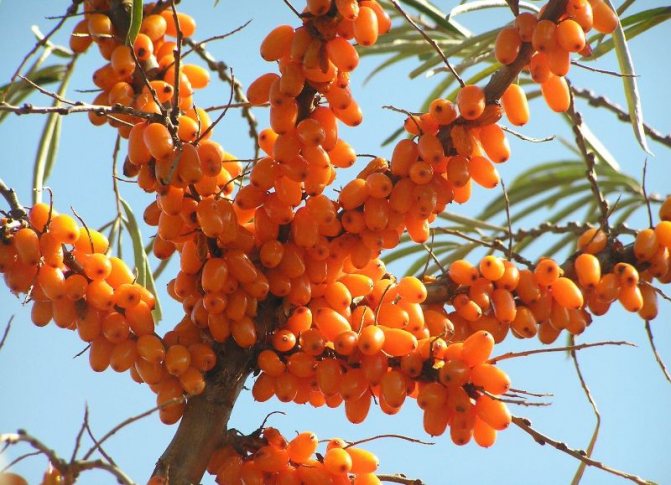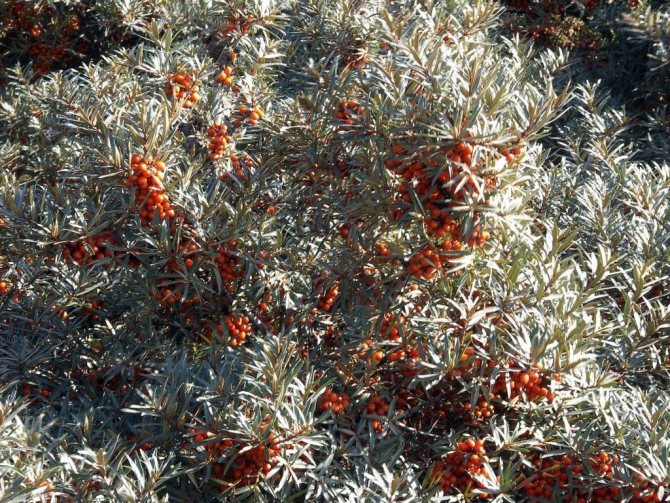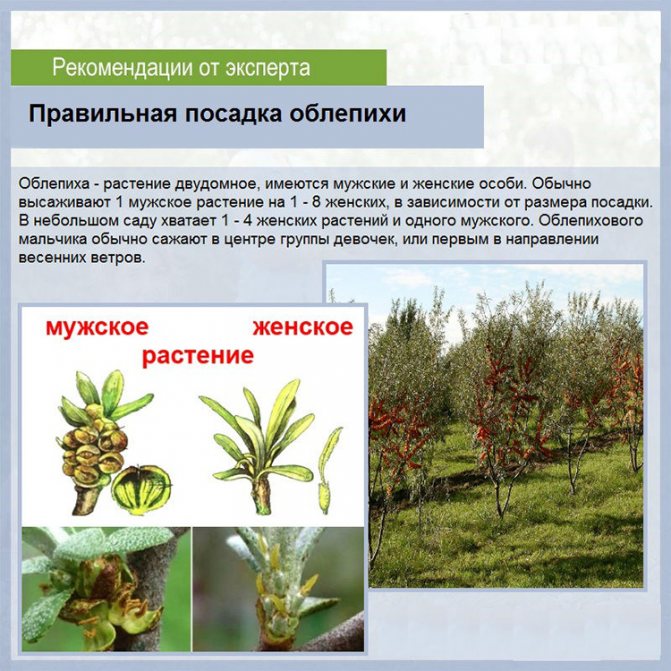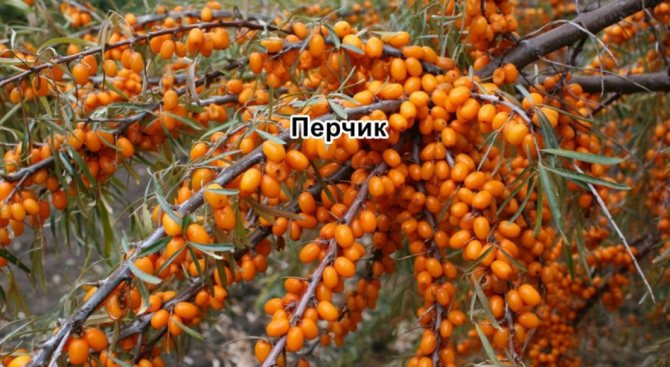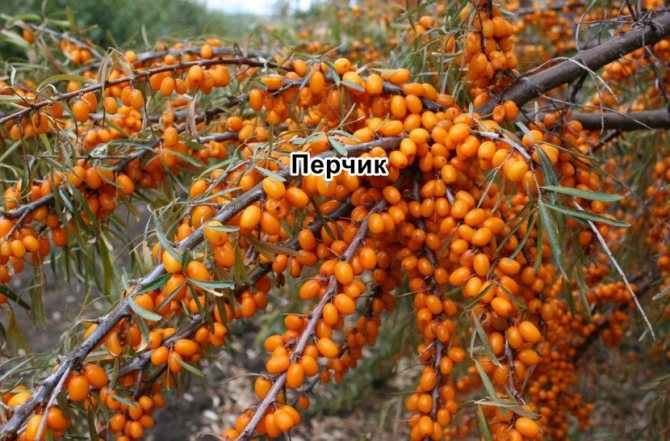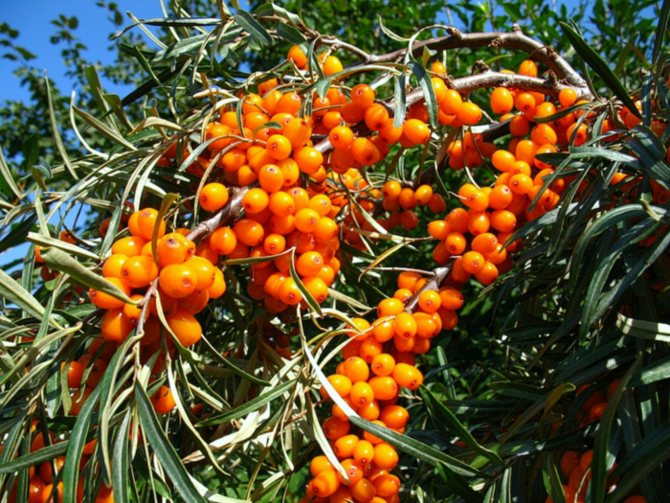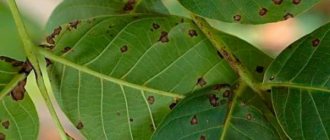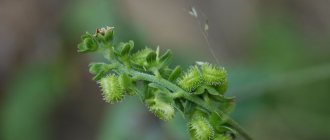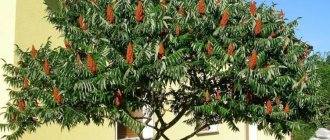What you need to know about sea buckthorn before planting?
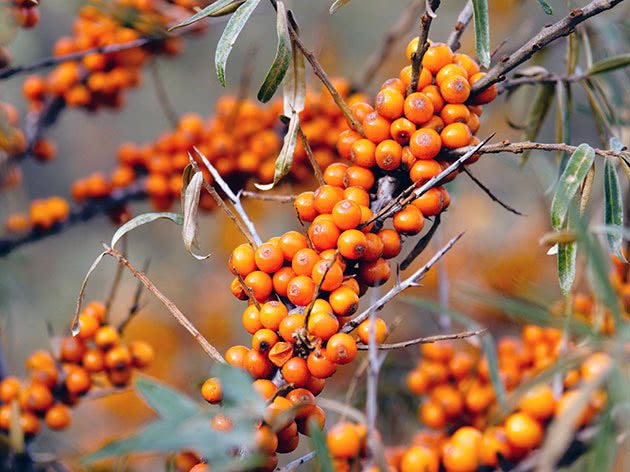
The dioecious plant is represented by two sexes: male and female. The cultivation of this representative of suckers takes into account such features. The difference between the sexes can only be noticed during flowering. Male-type plants have large buds with 5–6 scales. But the opposite, females, are several times smaller, they have only a couple of covering scales.
When growing trees, you need to consider the following features. One male sapling is capable of pollinating up to three female bushes. The first fruiting of the plant is observed at 4–6 years.
Variety selection
When choosing a variety, it is necessary to control the following criteria:
- compliance with a specific region;
- yield rate;
- ripening terms;
- taste qualities;
- thornless or common culture.
There are more than 60 varieties that grow on Russian territory.
Early varieties
- Pearl mussel is a frost-resistant variety with good yields. The berries are fragrant and have an orange hue. Disadvantages - does not tolerate drought well.
- Krasnoparodnaya is a vigorous plant of medium cold resistance, has thorns along the stem. It bears fruit with red berries, fragrant with sourness, weighing up to 1 g. Possesses high resistance to diseases.
- The Golden Cascade is a popular plant due to its lack of thorns. Advantages: resistant to diseases and pests. The disadvantage is average yield.
Sea buckthorn, medium ripening
- The glow is a frost-hardy variety, quite fruitful, has an average level of resistance to diseases. It has small thorns on the outside of the shoots. The berries are sour, crimson-orange in color.
- Favorite - a prickly bush, has an average size. bears fruit in large, carrot-colored berries. Advantage - high frost resistance and good resistance to parasites.
- Pepper is a low bush, very fruitful. Berries with sourness, orange blossom with a pineapple scent.
Late varieties
- Elizaveta is a high-yielding variety of domestic selection. The plant is miniature, has a crown. Fruits in large barrel-shaped golden berries. The pulp is tender and aromatic.
- Herringbone - the variety is resistant to frost and disease. Has a narrow crown, which resembles a spruce cone. bears fruit with small sour berries, lemon-colored with a green tint.
- The giant is a winter-hardy and consistently productive crop. A thornless bush, bears fruit with large ovoid orange-hued berries.
When to plant?


Weather conditions in different regions of the Russian Federation differ from each other. For the successful planting of this plant, the gardener needs to consider this important factor.
Volga region
This part of the country is characterized by moderate and long winters. You should start planting sea buckthorn not earlier than the first days of March. Gardeners recommend using only zoned varieties.
Middle lane
Shrub planting in the Moscow region is carried out at the end of March or a little later. It all depends on the weather in the spring.
Siberia
Planting of sea buckthorn in these regions is carried out as the onset of stable heat. This period falls on the end of April, beginning of May.
Choosing a landing site
The tree must be planted away from the area that is constantly being cultivated. A good location is a corner on the outskirts of a lawn, garden or vegetable garden, near a building or a road.This requirement is due to the growth of the plant's root system.
The roots grow and develop at a shallow depth, they diverge like a net. Therefore, it is easy to damage them if you dig up the soil.
The roots diverge several meters from the trunk, because of this, the shrub weakens if part of the root system is cut off.
Also an important factor when choosing a site for planting is a good provision of light access. Sea buckthorn does not tolerate shade, in such places it will not give a good harvest.
Overgrowth spread
For those who want to distribute this beautiful plant as quickly as possible, we recommend taking a closer look at this method. Shoots are taken as material for planting. It is necessary to injure the sea buckthorn root system with all known tools - a shovel. But we note that you could not have hurt the roots on purpose, since the root system of the sea buckthorn is widely spread in the soil. Then you need to build a hill next spring. These actions must be performed with special care. Next, you need to separate the roots and offspring with a knife. The place for planting must be prepared in advance in the fall, and then our material must be planted. Further, without fail, it will be necessary to feed the plant with additives and, of course, water it regularly. Reproduction using lignified cuttings The preparation of such cuttings must be done in advance - usually the last autumn month is chosen. The thickness of the cuttings should not be less than five millimeters, then they need to be removed in the snow. When spring finally comes, you need to cut the cuttings. The length should be about twenty centimeters. Further, after carrying out this procedure, the cuttings must be immersed in water for a long period of time - about two weeks. During this time, the first buds appear and even bloom on the cuttings, and you can notice small rudiments of the root system. It is necessary to prepare the place where you will plant the sea buckthorn in advance. During the period of digging the soil in the fall, about eight to nine kilograms of humus should be brought into the ground to one meter. In the spring, you need to dig again, and then very carefully trim the area ready for planting. When the sun begins not only to shine, but also to warm the earth, you need to carefully monitor the temperature. When the ground temperature is about five degrees above zero, you can start planting cuttings. But before planting, you will need to soak the cuttings in water for a while. Do not forget to leave some buds on the surface and water the planted cuttings regularly and on time. Also, it will not be superfluous to create mulch with fertilizer. After planting sea buckthorn cuttings, you are a parent, cuttings are your children, they need to be given special care and constantly monitor their current state, check the soil, the level of moisture. Long cuttings should be watered once every four days, while short cuttings should be watered daily. By the end of the season, the cuttings usually grow to normal size. And this means that next year in the spring it will be possible to safely start transplanting sea buckthorn to a permanent site. How do you know that the seedlings are ready for transplanting? The root system has formed and is about 18 centimeters long, that part of the seedling that is above the surface has grown to 45 centimeters, the root collar is about 10 mm. What are the advantages of this method? You do not need any skills that require honing and serious preparation. Reproduction by this method can be done even by a novice gardener. What are the disadvantages? If the level of air humidity is in a low state, then the likelihood that the cuttings will be able to take root well is small.
Soil preparation
Sea buckthorn needs moisture and light soils. Prepare a place for planting a plant in the fall.
You must first do the following:
- Reduce soil acidity. The soil for the shrub must be leveled and sprinkled with slaked lime on top (about 250-400 g / m2, then dig it up. After that, after 2 weeks, other fertilizers can be applied).
- Saturate the soil. It is necessary to apply organic fertilizers. Of the minerals, superphosphate and complex additives are useful. If the soil is heavy, sand is required (2 buckets for every 1 m2. You can lay the nutrient mixture throughout the entire plot of the proposed planting, as well as specifically in the holes. The distance between the dimples is 2 m. This solution is more profitable than spreading fertilizers over the entire area.
At what distance to plant sea buckthorn from each other. Landing, landing pit size
In most regions, sea buckthorn is planted in spring and autumn, in the northern regions of the European part of Russia - only in spring. One-year or two-year seedlings are planted in a permanent place. A good two-year-old seedling should have at least 4-5 roots 20 cm long and at least 2-3 shoots about 50 cm long in the aerial part.
A planting hole for a sea buckthorn bush is made 40-50 cm wide and 35-40 cm deep. The distance between plants should be at least 2.5 m in a row and 3 m between rows. In the center of the planting pit, a planting stake is installed, and a drainage with a thickness of about 10 cm is laid at the bottom (crushed stone, broken brick, shell rock and construction waste can be used as drainage).
On light soils, the soil taken out of the pit is mixed with organic and mineral fertilizers, on heavy clay and peaty soils, an earth mixture is prepared from garden soil (only a fertile layer), river sand and humus or peat (if it is not upstream, that is, not too acidic ) in equal parts and add 150-200 g of simple superphosphate and 30-40 g of potassium chloride to it.
Sea buckthorn is planted vertically, because with an inclined planting, the buds on the trunk awaken and the crown will be curved. The roots are evenly spread over the mound, gradually covering them with earth and shaking slightly so that all the voids around the roots are filled. The root collar is buried at least 3-5 cm below the soil level (on loose soils, it can be buried up to 10 cm). After filling the hole with soil, the newly planted plant should be watered with 2-3 buckets of water and the trunk circle should be covered with weathered peat (5-6 cm layer) or river sand (layer thickness 6-8 cm).
Preparation of seedlings


To get an excellent berry harvest, it is advisable to choose a varietal crop. Be sure to pay attention to the floor of the plant. Plant sea buckthorn two years old.
By this time, their height is 0.35–0.5 m, and the root system diverges by 0.2 m. When examining the plant, focus on the number of main roots - there should be at least 2-3, and a little more small ones.
Also, examine the condition of the bark. If it has peeled off, you cannot use the seedling. If there is a brown color on it, then this indicates a freezing of the seedling - such a shrub does not take root well or disappears altogether.
Further care of the plant
In the spring, before the first buds bloom, you need to form sea buckthorn bushes, giving them the desired shape, cutting off unnecessary branches. This should be done a year or two after planting, since the aerial part of the tree during this period is already well formed.
More attention should be paid to 4-5 year old trees. During this period, there is no need to spare the fruit-bearing branches, the excess weight of the aboveground part interferes with the tree. It is best to remove shoots that grow parallel to the trunk, and it is also imperative to prune dry branches.
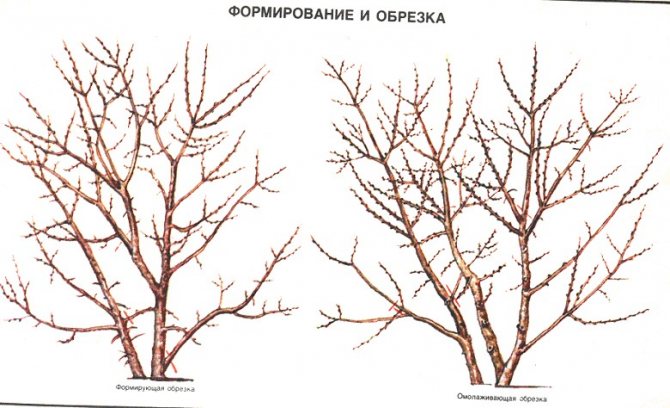

Shaping and pruning
In older plants that bear fruit for 8 years or more, a period of diseases may begin, the branches dry out, and the fruits become less strong, which can lead to a pest attack on the plant.There are anti-aging pruning techniques that can help bring sea buckthorn back to normal and return it to its former fertility.
Interesting: in some areas, sea buckthorn is grown not for fruit, but for decorative purposes, so branches are pruned regularly, because they give it the necessary shape, which can be either round or angular.
It is worth carrying out sanitary cleaning of sea buckthorn annually. It includes covering up various holes, cleaning dry branches and leaves, getting rid of the fungus. If the fungus has damaged most of the shrub, then it must be cut out and completely processed.
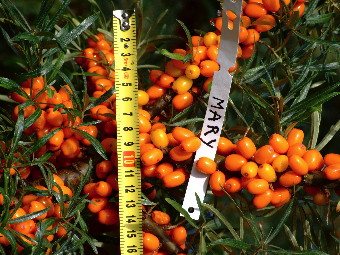

Mary grade
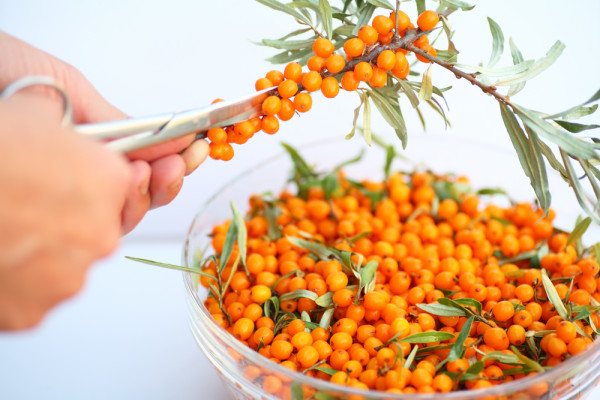

Picking sea buckthorn berries - shearing with scissors
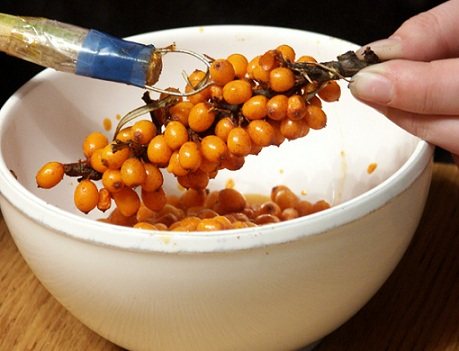

Picking sea buckthorn berries
How to plant?
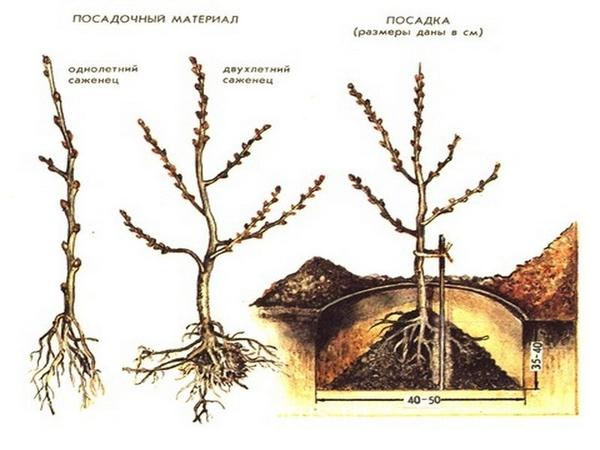

You can plant sea buckthorn in autumn and spring. Although when the tree is chosen in the fall, then the best option is planting in a container. This will prevent the plant from freezing.
Spring planting of a plant, as well as autumn activities, looks like this:
- Make a planting hole 35–40 cm in size, maintaining a depth of 40–50 cm. The deepening, regardless of the time of planting, should be prepared in the fall.
- Selecting the soil from the hole, separate the first layer from the second.
- Drive a peg into the center of the hole. You will need it for the garter.
- Soak a plant with an open root system in a solution of any growth stimulator - Kornevin, Heteroauxin.
- Fill the bottom of the pit with a nutrient mixture: add 1 bucket of compost or humus, 30 g of double superphosphate and half of this amount of potash fertilizers to the top layer soil. This proportion is recommended for 1 seedling.
- Make a mound from the soil taken from above, carefully spread the roots on it and cover it with soil, periodically spilling the depression with water until it becomes mud. Such an event will help the soil to adhere more tightly to the root system.
- Fill everything on top with the rest of the soil.
- The root collar should not be deeply buried. It should be at ground level.
- Form a circular hole around the sea buckthorn and sprinkle it again with 2 buckets of water.
- Mulch the plant around with peat, old sawdust or straw.
- Tie the seedling to a peg.
Disease and pest control
Forest mice and voles in winter can gnaw the bark of the trunk and branches of the lower tier, which are under the snow. Sea buckthorn also suffers from pests and fungal diseases.
Table: Protection against diseases and pests
| Diseases and pests | Signs of defeat | Control and prevention measures |
| Rodents (voles, mice) | Damage to the bark of trunks and main branches |
|
| Green sea buckthorn aphid | Curling, yellowing and death of leaves | Spraying with infusions:
|
| Sea buckthorn fly | Darkening and drying of berries |
|
| Scab of shoots, leaves and fruits |
|
|
| Fusarium fruit wilting |
|
|
Photo gallery: sea buckthorn diseases and pests


The sea buckthorn fly uses the fruit to feed and hatch larvae.
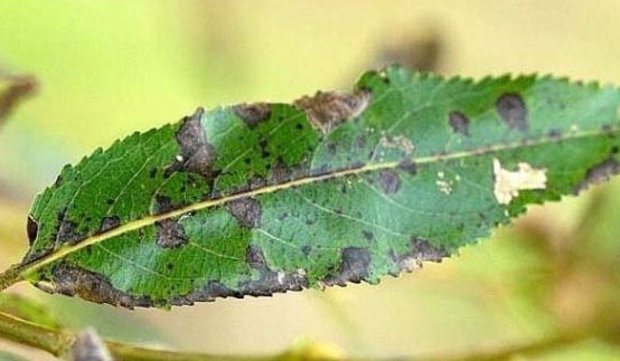

Scab infects leaves and berries, can completely destroy the plant


Green sea buckthorn aphid sucks juices from young leaves
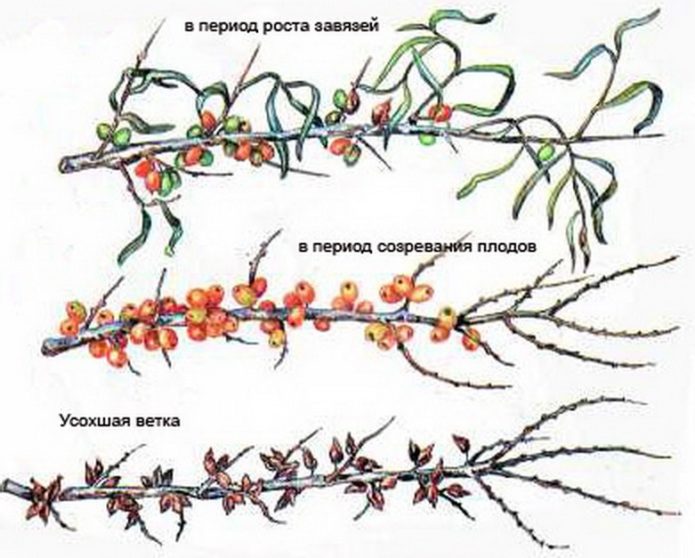

Fusarium disease leads to drying out and dropping of leaves and fruits
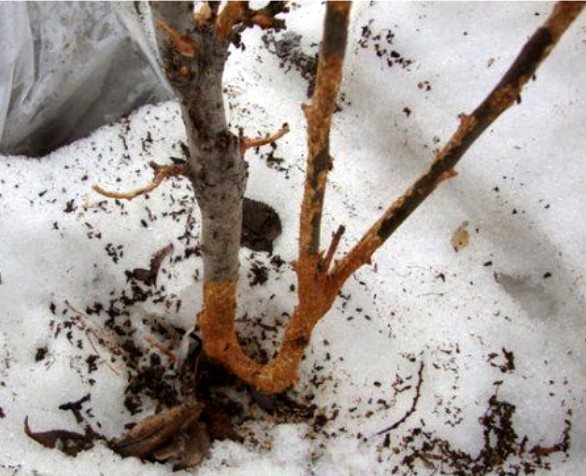

Mice gnaw the bark at the bottom of trunks and branches, which leads to the death of bushes
Differences in planting in spring and autumn
The process of planting sea buckthorn in autumn and spring has some distinctive characteristics. Planting the plant in spring allows the root system to strengthen well.
The reason is a pre-prepared fertilizer pit. During the winter period, they manage to infuse, this has a positive effect on the future harvest. The advantage of the spring procedure is the possibility of harvesting a year earlier.
The advantages of planting in autumn include less time spent caring for the plant after planting. Planted in autumn, the bushes begin to grow a couple of weeks earlier in the spring than just planted.
Also, in the fall, it is easier to identify the quality of seedlings, considering their foliage and other criteria. At the same time, the autumn sales of sea buckthorn save the family budget.
How to propagate by dividing the bush
To this kind of reproduction usually resorted to when transplanting a plant from one place to another.
Favorable time for the procedure - early spring or late autumn, but before the frost hits.
The bushes are dug up, all old branches are cut off, leaving only healthy ones. Shaking excess pieces of soil from the roots, divide the bush into parts using a garden pruner.
When dividing the bush, it is necessary to control the presence of a healthy root system in each part of the bush. The seedling must have developed roots, old rhizomes are removed, everything else needs to be trimmed.


Sea buckthorn can be propagated by dividing the bush; it is preferable to do this in early spring or late autumn, before frost
Care after landing
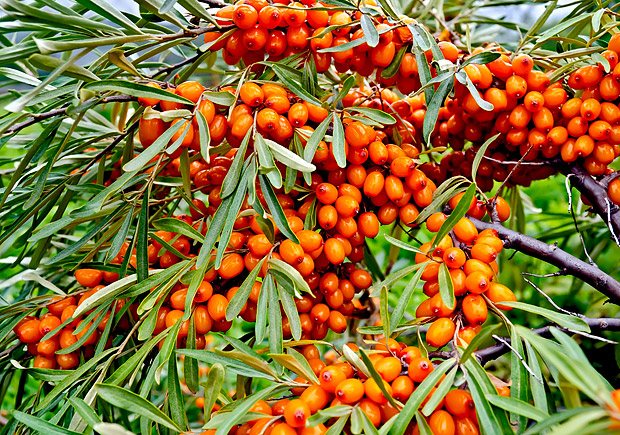

After the procedure for planting a seedling in the hole has been done, it is necessary to properly carry out further care for the shrub.
Depending on the time of planting sea buckthorn, different activities are required:
- watering;
- loosen the soil;
- mulch;
- fertilize;
- handle pests;
- perform trimming;
- shelter for the winter.
Treatment
In early spring, before the flowers appear and after the harvest, the plants should be sprayed with a 3% solution of copper sulfate or 1% Bordeaux liquid in order to prevent diseases.
If pests appear during the ripening period of berries on sea buckthorn, it is advisable to spray them once a week with Fitoverm or homemade ash infusion.
Watering
If the spring is dry, it is necessary to water the bushes before and during flowering. 1 plant requires up to 4 buckets of water. More mature cultures - 7 times more.
Sea buckthorn is a plant that loves moisture, although it does not tolerate stagnant water. Watering abundantly is required in the heat, avoiding the state of the swamp. In the fall, it is required to water the bush one and a half times more. This will create a good potential for the future harvest.
Top dressing
In order to get more new shoots, in early spring you need to fertilize the culture with urea (30 g per 1 bucket of water). A volume of 0.5 buckets is required under a tree.
Be sure to fertilize young seedlings with organic compounds - humus mixed in water. This action is required to be carried out once every 3 years.
Spring planting care
It is not at all difficult to take care of garden sea buckthorn, although you need to know certain nuances. By the end of March, when the weather gets warmer, perform a sanitary pruning of the tree, cutting out all damaged, injured, dried, drooping branches. After a couple of weeks, loosen the surface of the circle near the trunk a little.
In May, sea buckthorn needs to be watered, especially when there was little snow in winter and spring was not full of rain. If there is enough moisture, it is better to water the plant a little later.
In calm, calm weather at the time of flowering, the plant needs to organize additional pollination. Take a fresh branch of the male sea buckthorn shooting gallery and shake it over the female shoots.
Autumn planting care
After harvest, sanitize the sea buckthorn pruning again. Rejuvenate the bushes in the fall, processing only one tree per year.
If the autumn is dry, the bush must be watered abundantly. Also, this season, feed the sea buckthorn by adding phosphorus fertilizers and organic matter to the soil. To do this, dig up the soil shallowly.
Description
Sea buckthorn grows as a bush or tree up to 6 m high, bears fruit annually. Its long filamentous roots with nodules, enriching the soil with nitrogen, are located at a depth of 30 cm. The central root is only up to 60 cm, which indicates the poor wind resistance of the plant.
Sharp thorns are usually located along the gray branches and at their tips (although newer varieties are already with fewer and softer thorns).
Male (producing pollen) and female (fruiting) flowers develop on separate plants. Both begin to bloom after about four to five years. The flowers are yellow, inconspicuous, blooming from mid to late May.
It blooms for 2 to 10 days, depending on the weather. The fruits are tied in the third or fourth year after planting, and in full force the sea buckthorn bears fruit in the sixth year and then for eight to ten years with a total plant life of 50 years.
The berries are produced by female specimens. They form in dense clusters close to the branches. Ripen from early August to late September.
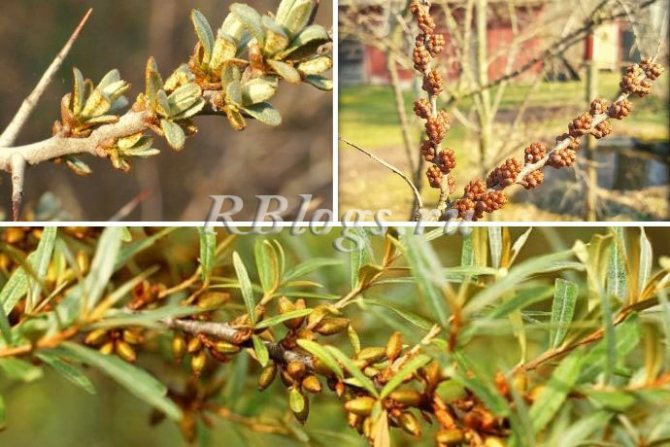

Reproduction of sea buckthorn


Sea buckthorn can be propagated in different ways:
- seeds, as well as cuttings;
- dividing the bush;
- vaccination;
- layering or overgrowth.
Each option is easy to use.
Seeds
If you want to get a varietal culture, it is better to use vegetative propagation techniques of the plant, since seedlings cannot repeat the varietal characteristics of the parent material.
With the help of seed propagation, new varieties of seedlings are developed. Also, sea buckthorn grown by means of seeds is used as a rootstock in the process of propagation of a shrub by grafting. Seed germination up to two years.
The breeding procedure is as follows:
- Perform preliminary stratification for 1.5 months at the bottom of the refrigerator.
- In April, sow the material without deepening and germinate in a warm place, covered with a transparent material (glass, film).
- In half a month, seedlings will appear.
- They need to be protected from the sun first.
- In the middle of the first summer month, transplant the young shoots to a permanent place.
- Before planting, pre-shorten the long taproot. This will stimulate root development.
Cuttings
This method is carried out by means of green cuttings or rooting of already lignified cuttings. They are harvested in late autumn, although it is better to cut them in early spring.
For this, two-year growths are suitable, cut into segments of 15–20 cm. Autumn cuttings must be tied in a bundle, then wrapped in a cloth and placed inside a plastic bag. It should be buried in a shallow hole, covered with snow or dry leaves.
In the spring, cuttings before planting need to be placed in water for three days, periodically changing it. Also add a root stimulant to the water. Then plant the cuttings at an angle in the ground, leaving 2-3 buds above the surface, cover the rest with soil.
By autumn, your stalk will grow to a height of 60 cm. Already in the third year, the sea buckthorn will begin to bear fruit. Green cuttings are more difficult to root. They need special conditions: loose soil mixture, washed sand on top.All this is required to be shed with a rooting stimulant, constantly sprayed with moisture to ensure sufficient air humidity.
Root shoots
This method is also used when a young tree is growing on the site. In the spring, you need to find a branch that has a good growth, pull it to the ground and place it inside a shallow groove.
Fix the branch there and cover it with earth. Water, feed, loosen the soil, remove weeds throughout the season. After a year, separate the layers by digging it out with the roots.
Transplant the plant to its permanent location. For such reproduction, only the shoots of self-rooted sea buckthorn, which grows farther than half a meter from its mother tree, are suitable.
Sea buckthorn in a pot. Growing sea buckthorn: secrets and subtleties


In recent years, the cultivation of sea buckthorn has attracted the attention of amateur gardeners more and more. You don't need special knowledge to grow sea buckthorn.
Sea buckthorn fruits have a pleasant peculiar taste, have high nutritional value and many useful properties, which are due to a large set of mineral and aromatic substances.
Sea buckthorn fruits contain vitamins C, K, A, B1, B2, B9, E, PP, as well as a large amount of trace elements, including magnesium, manganese, iron, sulfur, boron, titanium, aluminum.
A very tasty peculiar jam is prepared from its fruits, rubbed with sugar, and a very valuable oil is prepared from it, which is used in the treatment of burns.
Sea buckthorn is of two types: a tree up to 5 meters high or a dioecious deciduous shrub, pollinated by the wind. Her female and male flowers are located on different bushes. It begins to bloom in early spring, almost simultaneously with the appearance of leaves.
Sea buckthorn, like honeysuckle, reproduces in different ways: by seeds, green and lignified cuttings, layering and root suckers. But it must be remembered that if sea buckthorn is propagated by seeds, then it loses the features inherent in any varieties, and half of the seedlings grows as male plants that are not capable of fruiting.
If the plant reproduces vegetatively, then it begins to bloom and bear fruit at the age of 3-4 years, giving good yields annually.
How to plant sea buckthorn correctly
Sea buckthorn is a cold-resistant plant, it can withstand frosts up to -50 degrees. The soil is preferable for her sandy-pebble, but chernozems are just as good. It grows poorly on heavy soil and bears little fruit.
In addition, flooded and waterlogged areas are categorically unsuitable for growing sea buckthorn. It is best to plant sea buckthorn on neutral soil. You can do this both in the spring and in the fall, but in the fall it is still better.
The cultivation of sea buckthorn is slightly complicated by its dioeciousness. Therefore, I would like to recommend planting 1-2 male plants in a home garden or vegetable garden on several female plants (2-4), in which flowering begins earlier than in female plants by 1-3 days.
For planting, they dig a hole 50 cm deep and the same in diameter. Then you need to remove the soil from this hole and connect it with a bucket of compost or humus, add 60 g of potassium sulfate and 100 g of superphosphate. Pour all this into the planting hole and pour 2 buckets of dolomite liquid at the rate of 1 cup of dolomite flour per bucket of water. All this is covered with a layer of fertile soil.
The plant should stand vertically in the hole, while the root collar should be deepened by 5 cm. Having planted a bush, it must be watered, compacted and sprinkled with earth. The bushes are located at a distance of 2 meters from each other.
It is necessary to use local forms, since plants brought from other places give berries, but they do not gain all the useful properties in our conditions.
How to properly care for sea buckthorn
Caring for sea buckthorn consists of regularly cutting out the shoots and dry twigs, loosening the soil around the bushes, and regularly watering. It is advisable to water the sea buckthorn in a rain way. In hot weather it gives her special pleasure.
During the growing season, the plant needs to be fed several times. Basically, these should be foliar feeding.
The first feeding should be done at a time when the leaves are blooming with a solution of urea (requires 30 g of urea per bucket of water) or a solution of Ross fertilizer.
The second feeding is done at the very beginning of flowering. Spray with a solution of water and "Potassium humate" (add 30 g of a liquid substance to a bucket of water).
Then, after flowering, two more dressings are made similar to the second with an interval of 3 weeks.
To form a crown in one-year-old bushes that do not have branches, the top should be cut off. In subsequent years of cultivation, you need to do regular pruning of sea buckthorn, during which dried, frozen, excess branches and root growth are removed. After about 10 years, the bush needs to be rejuvenated.
As you can see, the cultivation of sea buckthorn does not require special knowledge and skills, and everyone can try their hand at growing on their site an original plant with silver leaves and yellow berries. Try it.
You may also be interested in the article "Garden shrubs. Types and general information ".
Read Business Gardening and get rich harvests with us.

